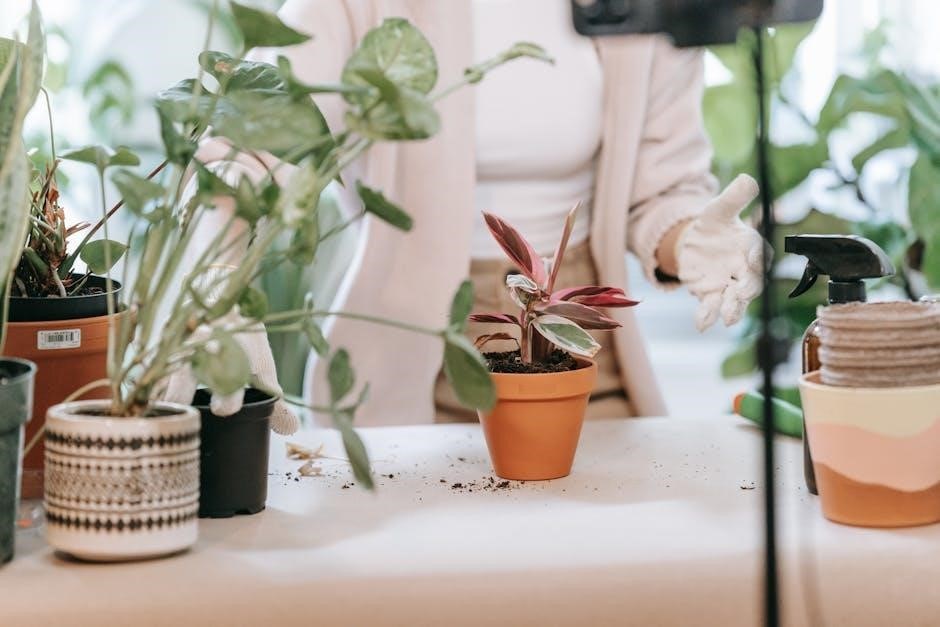Zone 6 offers a versatile climate, supporting both cold-hardy and warm-season crops. This guide provides essential tips and schedules to maximize your gardening success in Zone 6.
Understanding the Growing Season in Zone 6
Zone 6 has a medium-length growing season, typically lasting around 150 days. It begins after the last frost in early May and ends with the first frost in late September or early October. The average last frost date in Zone 6 is May 15th, marking the safe period to plant tender seedlings outdoors. This zone supports a wide variety of crops, from cool-season plants like lettuce and peas to warm-season crops such as tomatoes and corn. Understanding these timelines is crucial for planning and maximizing the productivity of your garden throughout the year.
Key Factors for Successful Gardening in Zone 6
Success in Zone 6 gardening hinges on understanding soil health, moisture management, and sunlight requirements. Testing and amending soil ensures optimal growth, while proper watering techniques prevent over-saturation. Selecting plants suited to Zone 6’s climate is crucial, as is timing plantings according to frost dates. Using mulch retains moisture and regulates soil temperature. Additionally, incorporating compost enriches the soil and supports robust plant development. Monitoring for pests and diseases, along with regular maintenance, further enhances productivity. By adhering to these practices and leveraging Zone 6’s moderate growing season, gardeners can achieve thriving, diverse gardens throughout the year.

Planting Calendar for Zone 6
Zone 6’s growing season typically runs from mid-April to mid-October, with the last frost date in May. This allows for a diverse range of spring, summer, and fall crops.
Spring Planting Schedule
Zone 6’s spring planting begins in late March to early April, with cold-hardy crops like lettuce, spinach, and peas thriving in cooler weather. Radishes and carrots can also be sown directly in early spring. As temperatures rise, transition to warm-season crops like tomatoes and zucchini after the last frost date in May. Start seedlings indoors 4-6 weeks before the last frost for a head start. Plant marigolds and sunflowers in late spring for vibrant summer blooms. Proper timing ensures optimal growth and maximizes the growing season in Zone 6’s moderate climate.
Summer Planting Schedule
Zone 6’s summer planting focuses on warm-season crops that thrive in heat. Plant beans, corn, and squash in late May or early June, after the soil warms. Tomatoes, peppers, and eggplants should be transplanted outdoors once the danger of frost has passed. Cucumbers, melons, and sunflowers also do well in summer’s warmth. Consider succession planting to extend the harvest season, sowing fast-growing crops like green beans or zucchini every few weeks. Keep soil consistently moist and mulched to retain moisture and suppress weeds. This schedule ensures a bountiful summer harvest in Zone 6’s favorable growing conditions.
Fall Planting Schedule
Zone 6’s fall planting schedule begins in late summer, about 8 weeks before the first frost. Cool-season crops like broccoli, kale, and spinach thrive in cooler temperatures. Plant Brussels sprouts, carrots, and beets in early August for a fall harvest. Radishes and lettuce can be direct-sown in late August or early September. Succession planting ensures a continuous harvest, with fast-growing greens planted every 2-3 weeks. Soil preparation is key; loosen soil and add compost before planting. Fall crops benefit from shorter daylight hours and cooler nights, making Zone 6 ideal for a productive autumn garden. Plan carefully to maximize the season.

Soil Preparation and Care
Proper soil preparation is essential for a thriving garden in Zone 6. Loosen soil to improve drainage and add compost to enrich fertility. Maintain balanced pH levels for optimal plant growth.
Testing and Amending Soil for Zone 6
Testing your soil is crucial to determine its pH and nutrient levels. Zone 6 soil often tends to be slightly acidic, with pH ranging from 6.0 to 7.0. Conduct a soil test annually to identify deficiencies. Based on test results, amend the soil with compost, manure, or fertilizers to balance pH and enhance fertility. Adding organic matter improves soil structure, drainage, and water retention, creating an ideal environment for root growth. Proper amendments ensure optimal nutrient availability, promoting healthy plant development and maximizing yields in Zone 6 gardens.
Best Mulching Practices for Zone 6 Gardens
Mulching is essential for maintaining healthy soil and plants in Zone 6. Apply organic mulch like wood chips or straw to retain moisture, suppress weeds, and regulate soil temperature. In Zone 6, mulch should be 2-3 inches thick, keeping it a few inches away from plant stems. Replenish mulch seasonally, especially after winter. Organic mulch decomposes over time, enriching the soil with nutrients. For optimal results, apply mulch after the soil has warmed in spring. This practice supports root health and promotes robust plant growth throughout the growing season, making it a cornerstone of successful gardening in Zone 6.

Choosing the Right Plants for Zone 6
Zone 6’s moderate climate supports a wide variety of plants. Choose cold-hardy crops like lettuce and peas for spring, and warm-season crops like tomatoes and squash for summer.
Cold-Hardy Crops for Early Spring
Cold-hardy crops thrive in Zone 6’s early spring, tolerating light frosts. Plants like spinach, kale, radishes, and lettuce can be sown as soon as the soil is workable. Peas and broccoli also excel, preferring cooler temperatures. These crops mature quickly, often within 30-50 days, making them ideal for early harvests. They require minimal care and can handle Zone 6’s unpredictable spring weather. Planting these varieties in late winter or early spring ensures a robust start to the growing season, providing fresh produce before warmer months arrive.
Warm-Season Crops for Summer
Zone 6’s summer is perfect for warm-season crops that thrive in heat. Vegetables like tomatoes, peppers, cucumbers, and squash are ideal. Plant beans, corn, and okra after the last frost for a bountiful summer harvest. Sunflowers and zinnias add vibrant color to gardens. These crops require full sun and well-drained soil. Start seeds indoors 4-6 weeks before the last frost date for a head start. With proper care, these plants will flourish during Zone 6’s warmest months, providing fresh produce throughout the summer season.

Seasonal Planting Tips
Zone 6 offers a balanced growing season, ideal for both cold-hardy and warm-season crops. Transition smoothly between seasons and prepare for fall to ensure year-round success.
Transitioning from Spring to Summer
As spring ends, Zone 6 gardens transition smoothly into summer. Remove spent spring crops to make room for warm-season varieties like tomatoes, peppers, and squash. Gradually acclimate seedlings started indoors to outdoor conditions before planting. Monitor soil moisture and temperature, ensuring it’s warm enough for heat-loving plants. Consider adding mulch to retain moisture and suppress weeds. Incorporate compost or fertilizer to replenish soil nutrients. Keep an eye out for pests and diseases that thrive in warmer weather. Proper planning ensures a seamless shift and maximizes summer yields.
Preparing for Fall and Overwintering Plants
As summer ends, Zone 6 gardeners should prepare for fall and overwintering. Clean up the garden by removing dead or diseased plants to prevent pests and diseases from overwintering. Amend the soil with compost or manure to enrich it for next year. Protect perennials by applying a layer of mulch or straw to insulate them from cold temperatures. Plant fall crops like spinach, kale, or Brussels sprouts, which thrive in cooler weather. Consider overwintering plants such as garlic or pansies, which can survive light frosts. Proper preparation ensures a healthy start for next year’s growing season.
Mastering the Zone 6 planting guide empowers gardeners to maximize their growing potential. With a medium-length season, Zone 6 supports a wide variety of plants, from cold-hardy crops to warm-season favorites. By following the detailed planting schedules and soil preparation tips, gardeners can enjoy a bountiful harvest. For further guidance, consult the USDA Plant Hardiness Zone Map or local nursery experts. Printable charts and online resources, like the Kellogg Garden Zone Planting Charts, offer additional support. Happy gardening, and enjoy the fruits of your labor in Zone 6’s versatile climate!